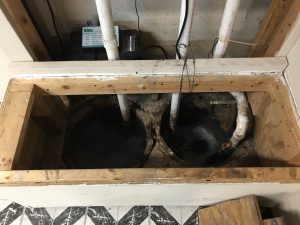Sump Pump Basics
 The (IDFPR) Illinois Department of Financial Professional Regulations is the governing authority for home inspectors. The IDFPR Subpart j) defines what is required to be done as a minimum for a home inspection. It is written as follows: When pursuant to the written agreement with a client, the plumbing system is observed, the home inspector shall describe in detail the interior water supply and distribution systems, including fixtures and faucets, drains, waste and vent systems; water heating equipment and vent systems; flues and chimneys; fuel storage and fuel distribution systems; drainage sumps, sump pumps and related piping; and location of main water and main fuel shut-off valves.
The (IDFPR) Illinois Department of Financial Professional Regulations is the governing authority for home inspectors. The IDFPR Subpart j) defines what is required to be done as a minimum for a home inspection. It is written as follows: When pursuant to the written agreement with a client, the plumbing system is observed, the home inspector shall describe in detail the interior water supply and distribution systems, including fixtures and faucets, drains, waste and vent systems; water heating equipment and vent systems; flues and chimneys; fuel storage and fuel distribution systems; drainage sumps, sump pumps and related piping; and location of main water and main fuel shut-off valves.
The rules (Standards of Practice) do not require that anything is tested or operated. We don’t agree with this and make sure every faucet, spigot, shower, and sink is tested for flow and drainage. The sump pump is also tested to see if it works along with the battery back-up. This, of course, is only if we can get to it. In other words, if the lid is sealed, we don’t remove it. We still make an attempt to operate the pump.
The skim about Sump Pumps
When a basement or crawl space is dug, we are creating a big hole in the ground. That hole will want to collect water when it rains. We build our home and place the backfill in that hole. The water will want to fill that hole and we have to create a path for the water to go so it does not pool up next to the foundation. Drain tiles are used around the perimeter of a home. The drain tiles are a tube with holes in them so water can enter. The tubes installed on the outside, or inside of the foundation wall. The water then travels to the sump pit in the basement or crawlspace. Inside the sump pit, we have a sump pump (and hopefully a backup sump pump).
New Construction
The best way to protect the basement from moisture issues when building a home is with proper site grading, the installation of gutters and downspouts, and the installation of an exterior footing drainpipe that drains to daylight, a dry well or a storm sewer. Since most of Chicagoland is flat, we usually don’t have that luxury. We need to install sump pits in our basement. Home inspectors should check for these components—as well as their functionality—to ensure that there is no excess water that could damage the foundation.
Remodeling
When renovating a house that has evidence of water issues, it is usually not feasible to construct an exterior drainage system. Instead, an interior drainpipe can be installed along the footing that drains to a sump pump. Even if the home inspector observes no signs of water intrusion in retrofit or new construction, a sump pit is sometimes installed in the basement floor slab as a precaution. If there are future changes in groundwater levels, a pump can be installed in the sump pit.
Sealing the Sump Pit
The sump pit should be covered with a metal, or plastic lid. This lid should be secure so that if someone steps on the lid, the person doesn’t fall and hurt themselves. If the home has a radon mitigation system, the sump pit must be sealed airtight and have a viewable window so you can see the pump and the water inside. While sump pumps are very effective in removing water, if they are not covered and installed properly, they can create additional water management issues, as well as indoor air quality concerns for the house. Sumps usually have standing water. If the sump pit is open or has a loose-fitting lid, this water can evaporate into the air, raising the relative humidity inside the home, basement, and crawlspace. This can promote mold growth, which is a health concern and can increase the moisture level of wood framing, inviting fungal decay and wood-eating pests.
Uncovered or improperly sealed sump pumps can also allow radon and other soil gases to enter the basement and crawlspace, and then mix with the air inside the home. Radon is a naturally occurring radioactive, carcinogenic gas found in varying levels in the soil and air. In high-radon areas, if soil gases are allowed to enter the home, radon can accumulate inside the home at potentially toxic levels.
Here are some installation requirements:
The electric sump pump should be installed according to the manufacturer’s specifications, making sure the float is unobstructed. The pump should be installed after the home’s electric meter has been set. This will allow testing of the pump to ensure that it’s operating properly and discharging water as intended.
“Charlie Says” There should also be a battery back-up on every sump pump. It is there not only in case you lose power, but also in case the pump fails, or the water intake is too much for the main sump pump to handle.

Charles Bellefontaine CMI, CPI, ACI
June 9, 2018
Uncategorized
No Comment